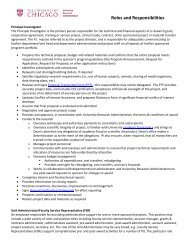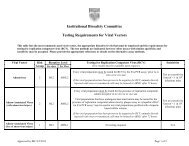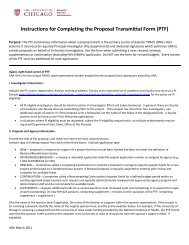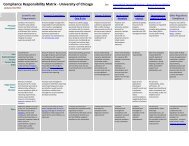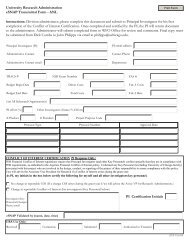e per<strong>for</strong>med under BL2 or BL2-N, according to the animal model, or under enhancedBL-2/BL2-N containment (see "General containment considerations"), so as to minimizethe risk of autoinoculation by the investigator. However, it may be permissible to reducethe containment level at some point following vector delivery. For example, if there is noexpectation of infection (see below), the site of inoculation has been thoroughlycleansed, and the bedding changed, it may be acceptable to consider reducingcontainment from BL2/BL2-N to BL1/BL1-N <strong>with</strong>in a few days (the specific time periodcan be specified by the local IBC, and may vary anywhere from 1-7 days depending onlocal and experimental considerations). Animals engrafted <strong>with</strong> human cells or animalhosts that are permissive <strong>for</strong> HIV-1 replication constitute a special case, in light of theirpotential to support replication of infectious HIV-1. Use of lentivirus vectors in theseanimals requires a higher level of containment.Other lentivirus vectors: Some non-human lentivirus vectors (e.g., FIV, SIV, EIAV,etc.) are also in use. Of these, the most frequently encountered are felineimmunodeficiency virus (FIV) vectors. In the Appendix B-V of the NIH Guidelines, acontainment level appropriate <strong>for</strong> Risk Group 1 agents is recommended <strong>for</strong> use ofcertain animal viral etiologic agents not associated <strong>with</strong> disease in healthy human adults.However, replication-defective vectors in which a heterologous envelope (such as VSV-G) is used <strong>for</strong> vector packaging may require BL2 containment in the laboratory setting,since these vectors have the potential to transduce human cells, and thus have thepotential to cause insertional mutagenesis. Under circumstances in which mice are notpermissive hosts <strong>for</strong> FIV replication, BL1 containment may be acceptable <strong>for</strong> mousehousing and husbandry when dealing <strong>with</strong> mice that have received FIV vectors (subjectto the considerations noted above).Summary: A comprehensive risk assessment and determination of containment <strong>for</strong>research <strong>with</strong> lentiviral vectors should consider the nature of the vector system,transgene insert, and type of manipulations involved. For many experiments, either BL-2or enhanced BL-2 will be appropriate. Examples of biosafety considerations and riskassessments <strong>for</strong> three different scenarios are included below.
Examples of <strong>Biosafety</strong> <strong>Considerations</strong>Vector <strong>Considerations</strong>:• Potential <strong>for</strong> generation of RCLo Vector and packaging functions separated onto multiple plasmidso Deletion of viral genes• Viral Env used in packaging systemo Non-native Env (decrease potential <strong>for</strong> generation of RCL)o Coat protein that increases species or cell type tropism of parentvirus (e.g., VSV-G)• Safety modifications (e.g., no expression of Tat)Transgene <strong>Considerations</strong>:• Oncogene• Non-oncogeneVector Generation <strong>Considerations</strong>:• Laboratory scale• Large scaleAnimal <strong>Research</strong> <strong>Considerations</strong>:• Permissive host• Non-permissive host• Animal engrafted <strong>with</strong> permissive cells• Vector Administration (e.g., injection)• Housing and husbandryPractices, Containment Equipment and Training <strong>Considerations</strong>:• Training in use of PPE• Availability of safety equipment (e.g., sealed centrifuge rotor cups)• Laboratory-specific safety and spill cleanup protocols• Availability of on-site occupational health support in the event of accident



